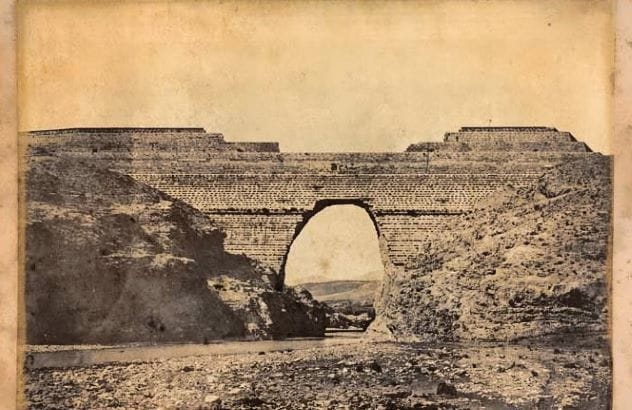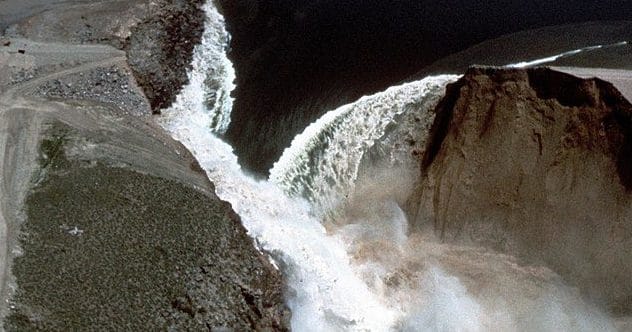Living near a large dam means placing immense trust in the engineers who designed and built it. These structures hold back incredible forces. If errors occur in their calculations or unforeseen events strike, the outcome can be a devastating catastrophe. When a dam breaches, the resulting surge of water can sweep away everything in its path, destroying property and tragically claiming human and animal lives. As this list demonstrates, when mistakes are made or disasters unfold, the consequences of dam failures can be truly horrific. It’s important to remember, however, that the vast majority of dams operate safely throughout their lifespan.
10. Banqiao Dam (China, 1975)
In August 1975, a super typhoon hit Henan province in western China, leading to terrible consequences. The Banqiao Dam, standing 387 feet (118 meters) tall, spanned the Ru River. Completed in 1952, this dam was made with a core of tightly packed clay covered by sand. Its main job was to supply water for irrigating farmland in the nearby Huai River Basin. The reservoir behind the dam could hold an astonishing 158 billion gallons (600 billion liters) of water.
The dam was designed to handle floods so rare they were expected only once in a thousand years. Sadly, such an event occurred just five years after the dam was finished. A ferocious typhoon brought extreme weather, dumping 55 inches (140 centimeters) of rain in only three days. This area usually received about 32 inches (81 centimeters) of rain in an entire year. The Banqiao Dam couldn’t withstand this onslaught. It failed, releasing a wall of water 33 feet (10 meters) high and up to 7 miles (11.3 kilometers) wide. Exact casualty numbers are difficult to confirm, but some estimates suggest as many as 230,000 people lost their lives.
9. Machchhu Dam II (Gujarat, India, 1979)
It was August 1979, and the Indian province of Gujarat was being soaked by torrential monsoon rains. This annual downpour, common across much of the subcontinent, was unusually intense that year. The Macchu River swelled dramatically, flowing deep and fast due to the near-apocalyptic rainfall.
The river became so engorged that the Machchhu Dam II had to open its floodgates. These gates are designed to protect the dam during times of extreme rainfall. However, releasing water wasn’t enough to prevent floodwaters from pouring over the dam’s earth banks. This overflow led to the structure’s destruction. Some people in the path of the released floodwaters had already moved to higher ground, which likely saved their lives. Many others were not so fortunate. Precise casualty figures are not available, but one estimate places the death toll as high as 25,000.
8. South Fork Dam (Pennsylvania, 1889)
The South Fork Dam, constructed from rock and packed earth, was located about 8 miles (13 kilometers) east of Johnstown, Pennsylvania. The original structure, built in 1852, was 918 feet (280 meters) long and 72 feet (22 meters) high. This initial version of the dam experienced a partial failure just ten years after its completion.
In 1872, a man named Benjamin Ruff purchased the remnants of the dam and the surrounding land. He planned to repair the dam and develop a luxury resort. This led to the creation of the South Fork Fishing and Hunting Club, popular with wealthy industrialists of the era, such as Henry Frick and Andrew Carnegie. Disaster struck on May 31, 1889, when a violent storm brought torrential rainfall, causing the dam to collapse. Modifications Ruff had made to the dam’s design were partly blamed for the failure. The breach released 20 million tons of water, resulting in 2,209 deaths in what became known as the Johnstown Flood.
7. Vajont Dam (Italy, 1963)
When the Vajont Dam in the Italian Alps was finished in 1959, it was one of the largest dams in the world. The structure itself was well-built and did not breach. However, a catastrophic flood still occurred in 1963, destroying property and lives. The disaster was caused by a massive landslide combined with the dam’s reservoir being filled beyond its safe limits.
The dam was already in a dangerous situation when an enormous landslide from the adjacent Monte Toc sent 9,200 cubic feet (260 million cubic meters) of rock crashing into the man-made lake. This huge displacement of water caused massive amounts to spill over the top of the dam. The ensuing deluge was so powerful that it created an air blast strong enough to tear clothes from the victims. The best estimate suggests around 2,000 people died in this tragic event.
6. The Ruhr Valley Dams (Germany, 1943)
The failure of two of the three Ruhr Valley dams in Germany during World War II had a unique cause compared to other disasters on this list. This dam failure was not an accident; it was a deliberate act of war. On a night in May 1943, a squadron of 19 Lancaster bombers from Britain embarked on a mission known as Operation Chastise. Their goal was to destroy these dams using specially developed “bouncing” bombs.
The original plan aimed to destroy all three dams, but only two, the Eder and the Möhne, were breached. The Sorpe Dam survived the attack. The destruction of the two dams caused widespread chaos on the ground. Of the 133 British airmen on the mission, 53 were killed. Those in the flood’s path suffered even more. German official figures stated 545 dead and missing. However, many foreign laborers and prisoners also lost their lives: 749 Dutch, Ukrainian, French, and Belgian individuals were killed or unaccounted for. In total, nearly 1,300 people perished.
5. Puentes Dam (Spain, 1802)

In 1802, the Puentes Dam in Spain’s southeastern Murcia region was the country’s longest, stretching 940 feet (286.5 meters). Located just over 7 miles (11 kilometers) from the city of Lorca, the dam stood 165 feet (50 meters) tall. Designed by Jerónimo Ortiz de Lara, its construction began in 1785 and took six years. Perhaps ominously, this dam was built to replace an earlier one that had failed in 1648.
The new dam had a difficult start. Its reservoir remained almost empty for nearly a decade due to severe drought in Murcia. However, the heavens finally opened with intense rainfall in March 1802. By the end of April, the dam appeared to be on the verge of overflowing. It was then that it failed, unleashing a 40-foot-high (12-meter-high) torrent of water directly towards Lorca. The flood destroyed over 800 homes, along with many industrial and farm buildings. The loss of life was also severe, with 608 people dying in the flood.
4. St. Francis Dam (California, 1928)
Completed in 1926, the St. Francis Dam was 700 feet (213 meters) long and located about 40 miles (64 kilometers) northwest of Los Angeles. Its purpose was to store water for the city’s aqueduct system. The concrete structure reached a height of 205 feet (62.5 meters). The Los Angeles Bureau of Waterworks & Supply was responsible for its construction, with chief engineer William Mulholland leading the project.
Mulholland was a self-taught engineer but had experience building several other dams. However, those were embankment dams, not concrete dams like St. Francis. This difference proved critical. Another key factor was a late design change: the dam’s height was increased by 20 feet (6 meters). Unfortunately, the impact of this height increase on the dam’s overall stability was not properly assessed. Just two years after its completion, in 1928, the dam failed catastrophically. This tragic event resulted in the deaths of approximately 400 Californians, marking one of the state’s worst civil engineering disasters.
3. Malpasset Dam (France, 1959)
Situated on the French Riviera near Cannes, the Malpasset Dam spanned the Reyran River. Construction began in 1952, and when it was finished two years later, the arch dam stood 218 feet (66.5 meters) tall and was just over 22 feet (6.7 meters) thick. It featured a single spillway at the center of its 736-foot (224-meter) length. The dam’s reservoir was finally filled to capacity in December 1959, and tragically, that’s when it failed.
In the days leading up to the collapse, the area experienced extreme rainfall and strong gales. These weather conditions likely contributed to the catastrophe that claimed the lives of 421 people. The death toll was higher than it might have been because flooded access roads delayed the arrival of rescue services. The subsequent investigation revealed that the Malpasset Dam had serious design flaws. These flaws were worsened by a lack of thorough geological surveys of the dam site.
2. Brumadinho Dam (Brazil, 2019)
The Brumadinho Dam in Brazil was not built to store water for irrigation or drinking. Its purpose was to hold toxic waste, known as tailings, from nearby iron ore mining operations. It was essentially a massive containment for millions of tons of poisonous mud and sludge. When this tailings dam failed in January 2019, it unleashed a torrent of toxic waste that engulfed nearby farms, communities, and parts of the town of Brumadinho, resulting in 270 deaths.
The Brazilian mining company Vale operated the mine. In 2021, Vale was ordered to pay $7 billion in compensation, a sum that could potentially increase. This incident stands as Brazil’s worst industrial accident and one of the deadliest environmental disasters. The flood of mud destroyed the village of Córrego do Feijão. An alarm system intended to warn villagers of danger failed to function on that fateful day. Many victims were workers at the mine or residents in the path of the sludge. The disaster highlighted severe issues with the safety and regulation of tailings dams.
1. Dale Dyke Reservoir (England, 1864)
The Dale Dyke Reservoir was located about 8 miles (12.8 kilometers) from the northern English city of Sheffield. The 100-foot-high (30-meter) dam was an earth embankment type. It stretched for 500 feet (152 meters) and held back a reservoir that was a mile (1.6 kilometers) long and a quarter-mile (0.4 kilometers) wide. In March 1864, as the structure neared completion and was being filled for the first time, a heavy storm hit the area, and the dam breached.
The collapse of the Dale Dyke Dam released an estimated 650 million gallons (2.95 billion liters) of water, which surged down the Loxley Valley. This destructive flood wave passed through several villages and small towns before reaching Sheffield. In parts of the city, the floodwaters rose to a depth of 6 feet (1.8 meters). Houses, pubs, factories, and other buildings were flattened by the force of the water. At least 240 people lost their lives in what became known as the Great Sheffield Flood. Investigations later pointed to issues with the dam’s construction and design as contributing factors to its failure.
These harrowing accounts of dam failures underscore the critical importance of meticulous engineering, ongoing maintenance, and vigilant oversight. While dams provide essential benefits like water supply and hydroelectric power, the potential for disaster when they fail serves as a somber reminder of the forces of nature and human responsibility.
What are your thoughts on these devastating events? Do you know of other dam failures with significant impact? Share your comments below.










